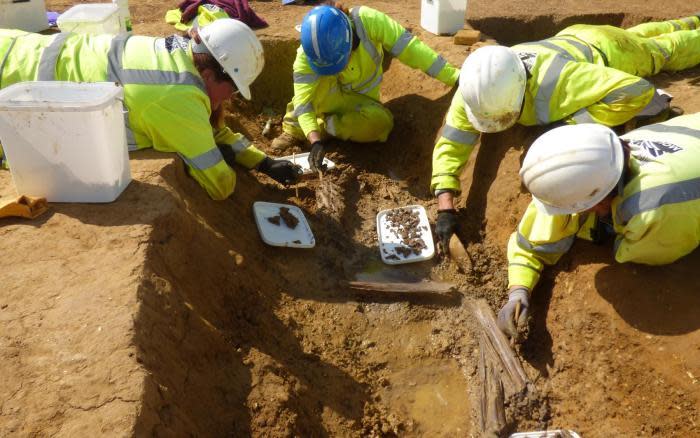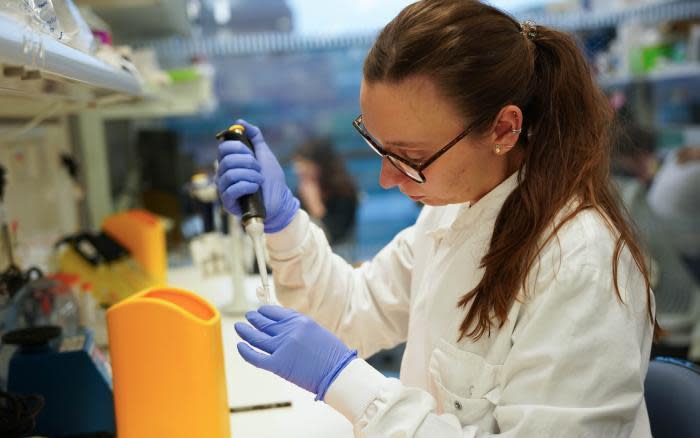DNA sleuths retrace journey of 2,000-year old corpse found in the U.K.

A man born 2,000 years ago in Russia ended up buried in England — and researchers think they've finally figured out how, thanks to DNA.
Scientists from London's Francis Crick Institute, Durham University in England, and MOLA Headland Infrastructure, a consortium of two U.K. archaeology companies, worked together to determine the globe-trotting history of a skeleton found in 2017.
The remains, found during a MOLA Headland Infrastructure excavation in Cambridgeshire, were buried near a rural farmstead. However, the man, known as Offord Cluny 203645, may have come from thousands of miles away, the scientists said in research published in Current Biology.

The DNA analysis was conducted as part of a project on ancient genomes in Great Britain, led by the ancient genomics laboratory at the Francis Crick Institute. Marina Soares de Silva, a postdoctoral fellow researching in the laboratory, said in a news release from the institute that she and her fellow researchers "began by extracting and sequencing ancient DNA from the bone of the individual's inner ear," noting that that was the spot that was best preserved. Ancient DNA is "very fragmented and damaged," Soares de Silva said, but the team was "able to sequence enough of his DNA to get good quality," and compare it to other samples of ancient individuals.
"The first thing we saw was that genetically he was very different to the other Romano-British individuals studied so far," Soares de Silva said. "In fact, our analysis showed that he had common ancestors with previously studied individuals from the Caucasus and Sarmatian groups."
The Sarmatians were a nomadic people who spoke Iranian and were renowned horse riders who lived in the area that would become modern-day Southern Russia and Ukraine, according to the release.

However, DNA testing alone couldn't confirm where the man was born, because his parents could have moved to the area before he was born. Researchers started focusing on other types of analysis, and soon, experts from the Department of Archaeology at Durham University were analyzing isotopes from the man's teeth to see where he grew up and how his diet may have changed during his life.
Those researchers found that the man "lived in an arid location in the east of continental Europe" until he was 5 or 6, according to Janet Montgomery, a professor at the university. His diet at that age focused on crops like "millet and sorghum, which are not native to Europe," Montgomery said.
As the man grew, he "migrated west, and these plants disappeared from his diet," Montgomery said. His diet changed again around the age of nine, indicating that he moved into Southeastern or Central Europe as a child before arriving in Britain and dying somewhere between the age of 18 and 25.
Researchers had multiple theories on how the man moved to Europe. One theory concerns a battle from 175 A.D., when then-Roman Emperor Marcus Aurelius defeated a Sarmatian army on the empire's northeastern border. He incorporated the cavalry into his legions and sent some of them to Britain, making it possible the man moved with them as a child. Alex Smith, a post-excavation manager for MOLA Headland Infrastructure, said that this theory "ties into previous burial evidence from Britain which suggests entire families may have joined the 5500 members of the Sarmatian cavalry sent to Britain by Marcus Aurelius."
"Did this young man grow up to become part of this cavalry unit? We can't say, because we don't have any finds or objects from his grave that connect him to either the Roman army, or the Sarmatians," Smith said. "Generally, we have very limited evidence for the Sarmatians stationed in Britain. We know they were likely on Hadrian's Wall, and at Catterick in North Yorkshire, but they may well have been divided across the country. If this young man was part of the cavalry, then perhaps he died on route to a military site."
Long-distance travel was also common during this period, making it possible that the man moved for his own reasons. The effects of those movements were most often seen in "cities or military locations," according to Tom Booth, a senior laboratory research scientist at the Francis Crick Institute, but the man moved from one rural area to another, showing a new sort of travel.
"It has previously been argued that rural life was largely unaffected by Roman rule – but this shows a clear influence in rural areas," Booth said.
Trump plans to appeal Colorado ruling barring him from primary ballot
Breaking down the U.S.-Venezuela prisoner swap
Trump denies reading "Mein Kampf" in first rally after Colorado ballot ruling
